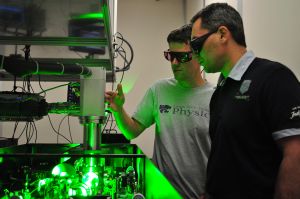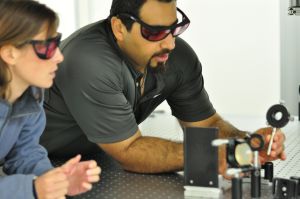AMO @ JRM
If you can read this, your browser is unable to properly import or use
Cascading Style Sheets (CSS). Please upgrade to a more modern browser.
Atomic, molecular and optical physics research at the James R. Macdonald Laboratory.
AMO Physics Program
 The
Kansas State University
Atomic, Molecular, and Optical Physics (AMO) program is one of
the largest in the country and ranked
among the elite programs in atomic physics by
US News and World Report.
The faculty is funded by a diversity of grants from the
Department of Energy, the
National Science Foundation, the
Office of Naval Research,
the Air Force Office of Scientific Research and the
Research Corporation.
The AMO group consists of
nine experimentalists
and
four theorists who are
Physics
faculty members. The group also has
experimentalists who are Physics research faculty
members and in addition has many
research associates in both
experiment and theory. The
graduate students working in the AMO
research program are funded by GRA stipends from the research grants and
are encouraged to attend national
scientific meetings to present the
results from their research. We are always
seeking new graduate students.
The
Kansas State University
Atomic, Molecular, and Optical Physics (AMO) program is one of
the largest in the country and ranked
among the elite programs in atomic physics by
US News and World Report.
The faculty is funded by a diversity of grants from the
Department of Energy, the
National Science Foundation, the
Office of Naval Research,
the Air Force Office of Scientific Research and the
Research Corporation.
The AMO group consists of
nine experimentalists
and
four theorists who are
Physics
faculty members. The group also has
experimentalists who are Physics research faculty
members and in addition has many
research associates in both
experiment and theory. The
graduate students working in the AMO
research program are funded by GRA stipends from the research grants and
are encouraged to attend national
scientific meetings to present the
results from their research. We are always
seeking new graduate students.
 The AMO program has a long history of research in ion-atom collision
physics dating back to the early 1970's.
Broadly speaking, the theme that unites the JRML current activities is
the study of dynamical processes involving ions, atoms, molecules,
surfaces, or nanostructures exposed to short, intense bursts of
electromagnetic radiation. During the period of 1974-2000 this was
carried out using collisions of energetic ions from our
Tandem van de Graaff and
LINAC accelerators, or of slow, highly charged ions from our
EBIS and
ECR ion sources, with atoms, molecules, clusters and surfaces.
More recently the Lab has added "ultrafast" intense laser
facilities
(including
FLAME, the Femtosecond LAser for Multicolor Experiments;
PULSAR, the Prairie Ultrafast Light Source for Attosecond Research and
a new, yet-unnamed high-repetition-rate laser system)
and hired new faculty to develop
and use them. Even though the laser pulses are actually longer than the
collision time scales traditionally studied in the JRML and the electric
fields generated by the "intense" laser pulses are typically weaker,
using the lasers to interrogate the same targets provides one important
benefit - control. The time-dependent profile of the laser pulse can be
shaped by the experimentalist and addresses all targets within the
interaction volume simultaneously. The presence of the the lasers has resulted
in a shift in the direction of much of the program away from pure
collisions toward intense-laser-matter interactions. A major strength of
the laboratory has been the presence of a large number of both
experimentalists and
theorists working in the same area, often in
collaboration with each other. The science is driven by both theory and
experiment.
The AMO program has a long history of research in ion-atom collision
physics dating back to the early 1970's.
Broadly speaking, the theme that unites the JRML current activities is
the study of dynamical processes involving ions, atoms, molecules,
surfaces, or nanostructures exposed to short, intense bursts of
electromagnetic radiation. During the period of 1974-2000 this was
carried out using collisions of energetic ions from our
Tandem van de Graaff and
LINAC accelerators, or of slow, highly charged ions from our
EBIS and
ECR ion sources, with atoms, molecules, clusters and surfaces.
More recently the Lab has added "ultrafast" intense laser
facilities
(including
FLAME, the Femtosecond LAser for Multicolor Experiments;
PULSAR, the Prairie Ultrafast Light Source for Attosecond Research and
a new, yet-unnamed high-repetition-rate laser system)
and hired new faculty to develop
and use them. Even though the laser pulses are actually longer than the
collision time scales traditionally studied in the JRML and the electric
fields generated by the "intense" laser pulses are typically weaker,
using the lasers to interrogate the same targets provides one important
benefit - control. The time-dependent profile of the laser pulse can be
shaped by the experimentalist and addresses all targets within the
interaction volume simultaneously. The presence of the the lasers has resulted
in a shift in the direction of much of the program away from pure
collisions toward intense-laser-matter interactions. A major strength of
the laboratory has been the presence of a large number of both
experimentalists and
theorists working in the same area, often in
collaboration with each other. The science is driven by both theory and
experiment.
Our Contact Information:
JRM Laboratory
306 Cardwell Hall
1228 N. MLK Drive
Kansas State University
Manhattan, KS, USA
66506-2604
Voice: 785-532-1527
Fax: 785-532-6806
jrmlab@phys.ksu.edu
Last updated on Friday, 05-Jan-2024

